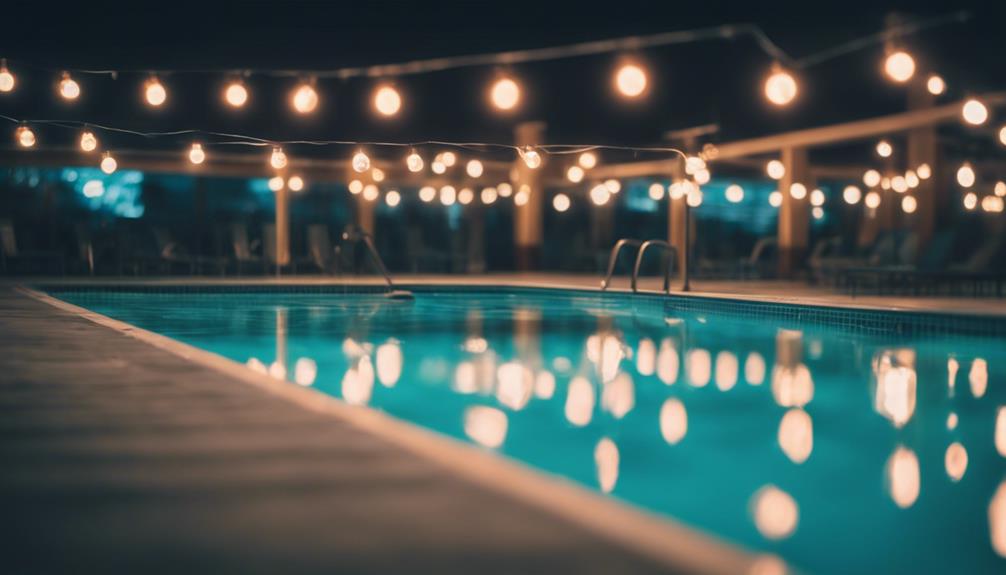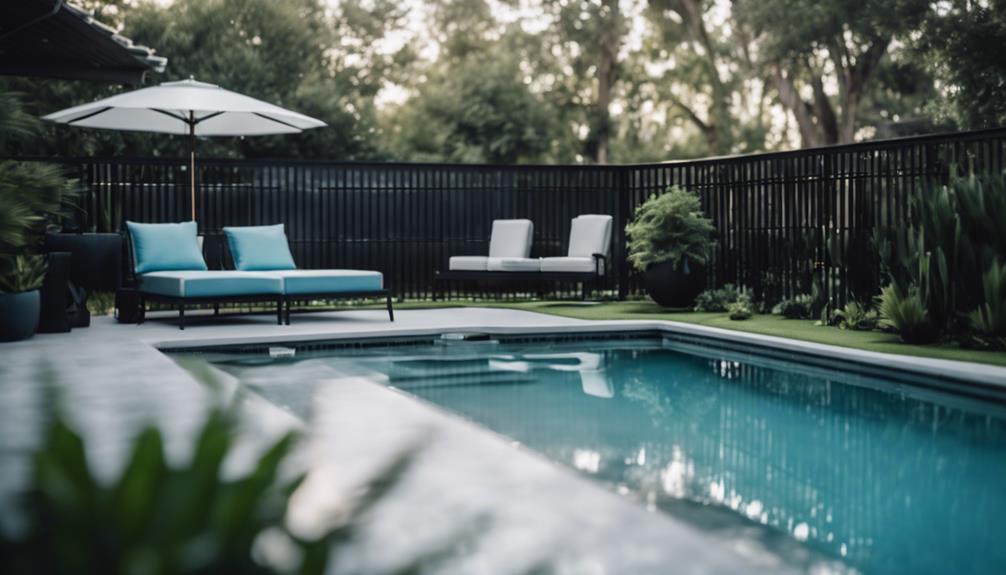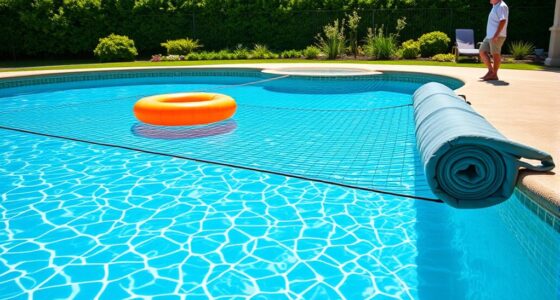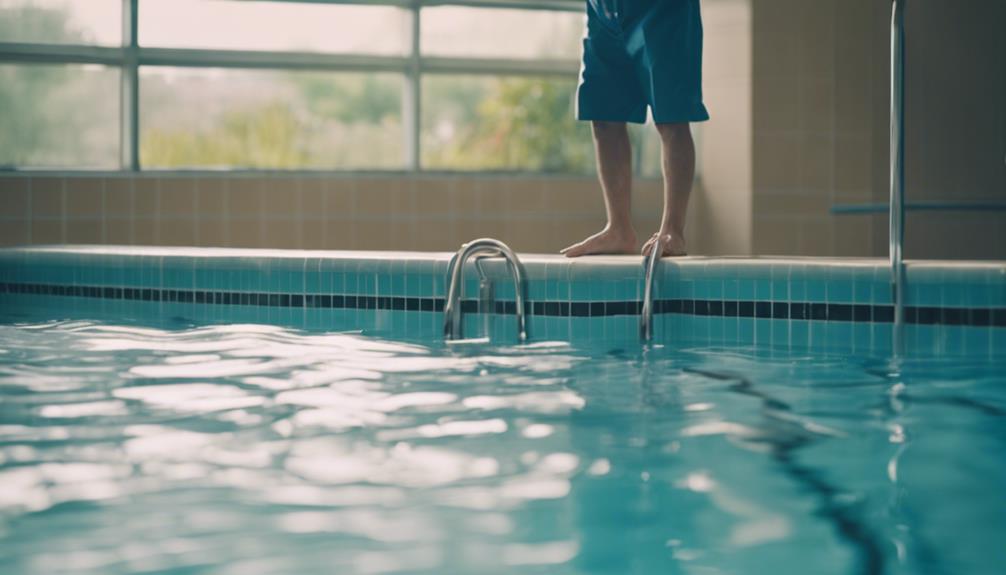When it comes to swimming pool lights, safety is crucial for a worry-free swim. To ensure a safe environment, it is important to enlist the services of a qualified electrician for installation to prevent accidents. Regular checks for faulty wiring or damage are also necessary. Additionally, incorporating ground fault circuit interrupters can help reduce the risk of electric shocks. By following these guidelines, you can enjoy swimming under the pool lights without any concerns. For more information on how to guarantee safety and proper installation, there are numerous useful tips to further explore.
Key Takeaways
- Use GFCIs for shock prevention.
- Opt for low voltage lights.
- Ensure proper waterproofing.
- Hire professionals for installation.
- Regularly maintain and inspect.
Importance of Pool Lighting Safety
Installing pool lighting securely is essential to prevent potential hazards associated with underwater electrical components. When it comes to POOL lights, ensuring proper electrical safety is vital to keep your swimming area safe. To guarantee that your underwater pool lighting is installed correctly, always hire a licensed electrician. These professionals have the expertise to set up the lights following safety protocols, reducing risks of accidents.
Regular maintenance plays a significant role in keeping your pool lights safe. Inspections help detect any faulty wiring or damaged components that could pose a danger. Remember, safety first!
Ground fault circuit interrupters (GFCIs) are also a great addition to your pool lighting system. They automatically cut off power in case of water contact, lowering the chance of electrocution incidents.
Choosing the Right Pool Lights
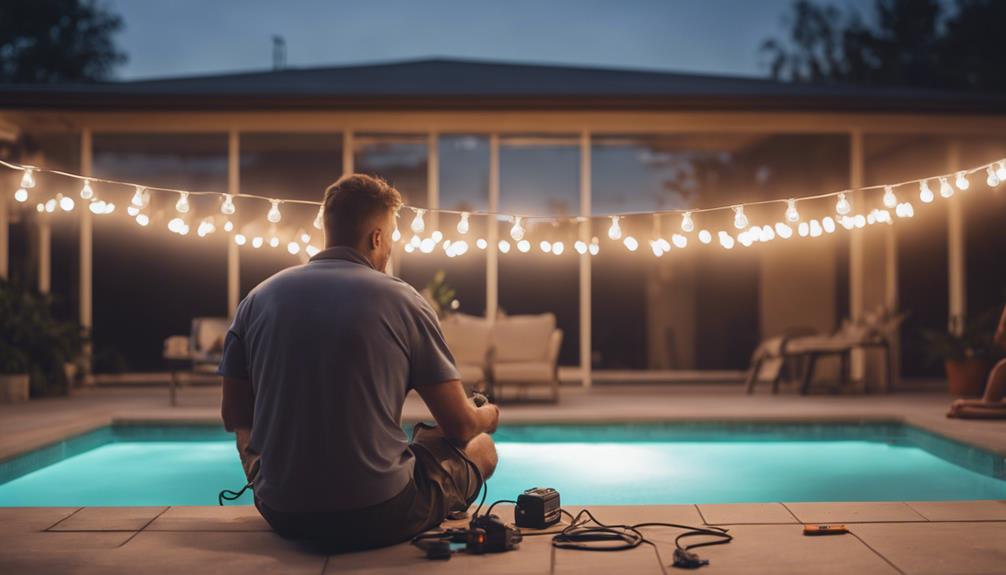
To guarantee maximum safety and aesthetics for your swimming pool, selecting the right pool lights is important. LED pool lights are a fantastic choice due to their energy efficiency, brightness, and safety features.
When choosing underwater lights, consider factors like the size of your pool, existing lighting, and your desired ambiance. White pool lights offer excellent visibility and safety, while color-changing lights can create a fun and unique atmosphere.
It's vital to look for fixtures that meet safety standards, have a high waterproof rating, are durable, and promote energy efficiency. Proper installation of these lights is also key to ensuring they function correctly and safely.
Additionally, placing adequate lighting near footpaths and steps can enhance safety around the pool area, reducing the risk of accidents.
Electrical Safety Precautions
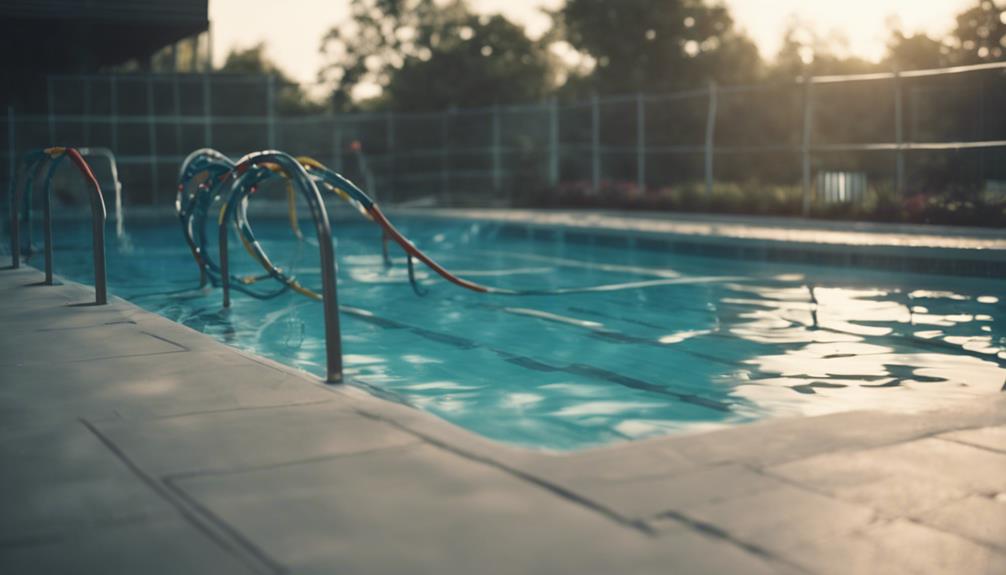
Ensuring electrical safety precautions are diligently observed is vital when installing and maintaining pool lights to prevent potential hazards. Here are some tips to help you reduce the risks associated with pool lighting installation:
- Use GFCIs: Installing Ground Fault Circuit Interrupters (GFCIs) is essential for safety. These devices quickly cut off power in case of an electrical fault, preventing electric shocks.
- Opt for Low Voltage Lights: Choosing pool lights that operate at a maximum of 12V internally and externally can greatly reduce the risk of electric shock hazards.
- Grounding and Class III Protection: Ensure that underwater lighting in pools is properly grounded and uses Class III electrical protection. This step is vital for preventing accidents and ensuring safety.
- Follow Safety Standards: Adhering to National Electrical Code standards and safety measures during pool lighting installation is key to creating a safe swimming environment for everyone.
Proper Pool Lighting Design
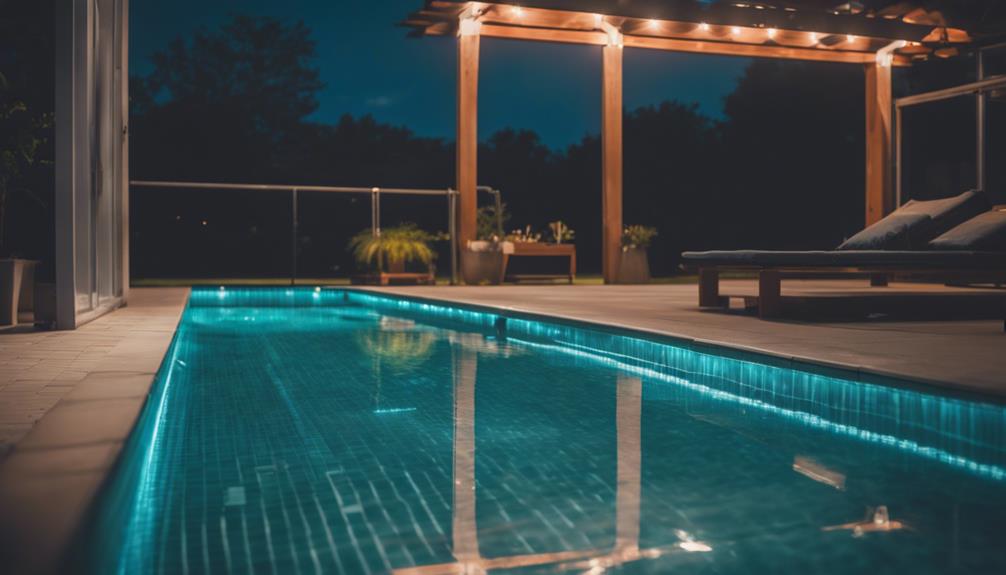
Ready to shed some light on proper pool lighting design?
Let's talk about how to strategically place those lights to enhance safety without blinding anyone.
We'll also cover some key wiring safety measures to keep everything running smoothly.
Lighting Placement Guide
Begin by strategically placing lights around your pool to enhance safety and aesthetics with proper pool lighting design. Here's a quick guide to help you make the most of your swimming pool lighting installation:
- Illuminate Key Areas: Guarantee that stairs, walkways, and any curved edges are well-lit to prevent accidents and create a visually appealing environment.
- Balance Brightness: Avoid overly bright lights that can dazzle swimmers. Opt for a harmonious lighting scheme that provides ample visibility without being harsh on the eyes.
- Follow Pool Layout: Let the shape and layout of your pool guide you. Place lights in a way that complements the pool's design and enhances its features.
- Highlight Focal Points: Emphasize areas of interest like unique pool features or architectural elements with carefully placed lights to create an engaging ambiance.
Wiring Safety Measures
Illuminate your pool safely by implementing proper wiring measures in your pool lighting design. When it comes to swimming pools, ensuring electrical components are grounded is essential to prevent any shocks.
Make sure that all your underwater pool lights are connected correctly and meet safety specifications. Installing ground fault circuit interrupters (GFCIs) is a necessity to automatically cut off power if water contact occurs, keeping you and your loved ones safe.
Additionally, all electrical elements near water need to be well-sealed and regularly maintained to minimize any risks. Remember, improper installation or neglecting wiring safety measures can lead to hazardous situations.
To guarantee the utmost safety, always rely on licensed electricians for any pool light installations or repairs. By taking these precautions and prioritizing wiring safety, you can enjoy your pool worry-free and bask in the beautiful illumination it provides.
Safe Installation Techniques
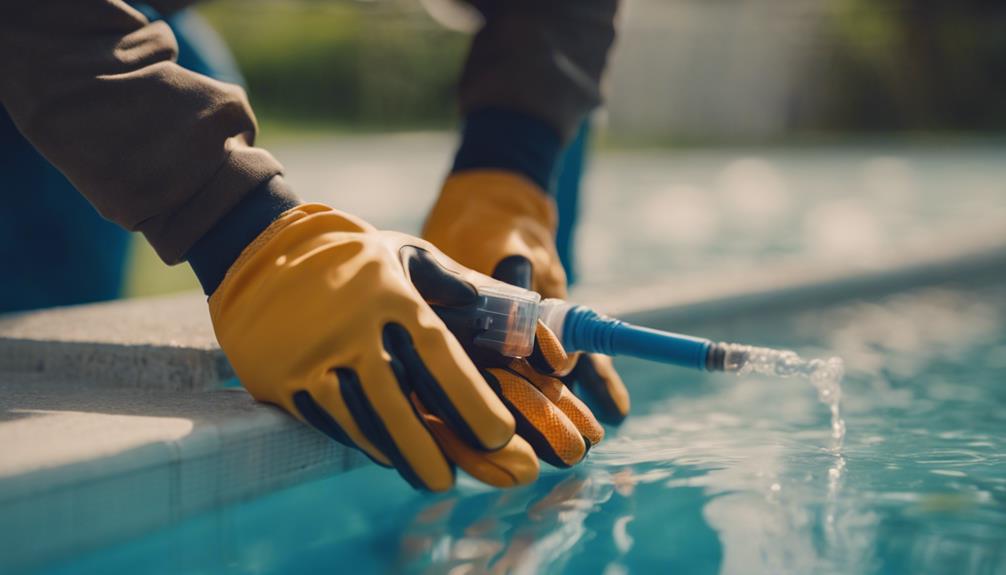
When it comes to installing pool lights, you want to make sure you're using proper wiring techniques. Ensuring that your lights are grounded is key in preventing any electrical mishaps.
And don't forget to apply waterproof sealant for that added layer of protection.
Proper Wiring Techniques
Guarantee the safety of your swimming pool lighting installation by utilizing proper wiring techniques. This includes using waterproof connectors and grounding the fixtures.
To guarantee your pool area remains hazard-free and your lights shine brightly, follow these tips:
- Use Waterproof Connectors: Opt for connectors specifically designed to keep water out and protect the wiring from moisture.
- Seal All Connections: Apply sealant or waterproof tape to cover and secure all electrical connections, preventing water intrusion.
- Avoid Splicing: Refrain from cutting and reconnecting power cords, as this can lead to electrical hazards and potential malfunctions.
- Hire a Licensed Electrician: For a foolproof installation, consider enlisting the expertise of a licensed electrician who can assure that your pool lights are installed following safety standards and proper wiring techniques.
Grounding for Safety
Proper grounding of swimming pool lights is fundamental for ensuring electrical safety and preventing hazards. When you install pool lights, remember that grounding is like giving your lights a safety net. It directs any stray electricity away from the water and people, reducing the risk of electrical shock.
Think of grounding as a shield that protects your pool and equipment from damage and fire. Without proper grounding, there's a higher chance of electrical malfunctions that can put everyone at risk. So, when setting up your pool lights, make sure to follow the right installation techniques, especially when it comes to grounding.
It's not just about making things work; it's about ensuring they're safe. By ensuring proper grounding, you're taking an essential step towards creating a secure swimming environment for you and your loved ones. Remember, safety always comes first, especially when dealing with electricity near water!
Waterproof Sealant Application
Applying waterproof sealant accurately is crucial when installing pool lights to guarantee a watertight seal and prevent water infiltration. To guarantee a safe and secure installation, follow these simple steps:
- Choose the Right Sealant:
Opt for a silicone sealant specifically designed for underwater use to effectively prevent water entry.
- Thoroughly Cover Gaps:
Make sure to apply the sealant generously to cover all gaps and openings around the pool light fixture.
- Regular Inspections:
Regularly inspect the sealant for any signs of wear or damage, and reapply as needed to maintain the waterproof integrity.
- Utilize Silicone Sealants:
Silicone sealants are ideal for pool lights as they're resistant to water, chemicals, and temperature changes, ensuring a long-lasting and secure seal.
Preventing Glare and Reflections

To prevent discomfort and improve visibility, strategically position your pool lights to minimize glare and reflections. When setting up your underwater pool lights, make sure they have proper shielding to reduce the glare bouncing off the water's surface.
Adjustable pool lights are a great option since you can control the direction and intensity of the light, helping to lessen any reflections that might be bothering you.
Don't forget to give your pool lights and lenses a good clean regularly to prevent any dirt or debris from building up and making the glare worse.
Also, consider your pool's surroundings and any reflective surfaces nearby when installing the lights to help minimize glare and reflections.
Ensuring Water Safety Around Lights

Positioning your pool lights strategically not only helps prevent glare and reflections but also plays an important role in ensuring water safety around lights. Here are some essential tips to keep your pool area safe:
- Prevent Electrical Hazards: Make sure your pool lights are properly grounded and installed to prevent any electrical mishaps that could pose a risk to swimmers.
- Regularly Inspect and Maintain: It's important to routinely check your pool lights for any signs of wear or damage. Timely inspections can help identify and address potential safety issues early on.
- Install Fault Circuit Interrupters: Consider installing fault circuit interrupters to quickly detect electrical faults and shut off power to the lights, reducing the risk of electric shock in the water.
- Reduce the Risk: By following safety standards, waterproofing measures, and getting professional installations and replacements when needed, you can significantly lessen the risk of accidents around your pool lights.
Taking these precautions will ensure that your pool remains a safe and enjoyable environment for everyone.
Regular Pool Lighting Maintenance
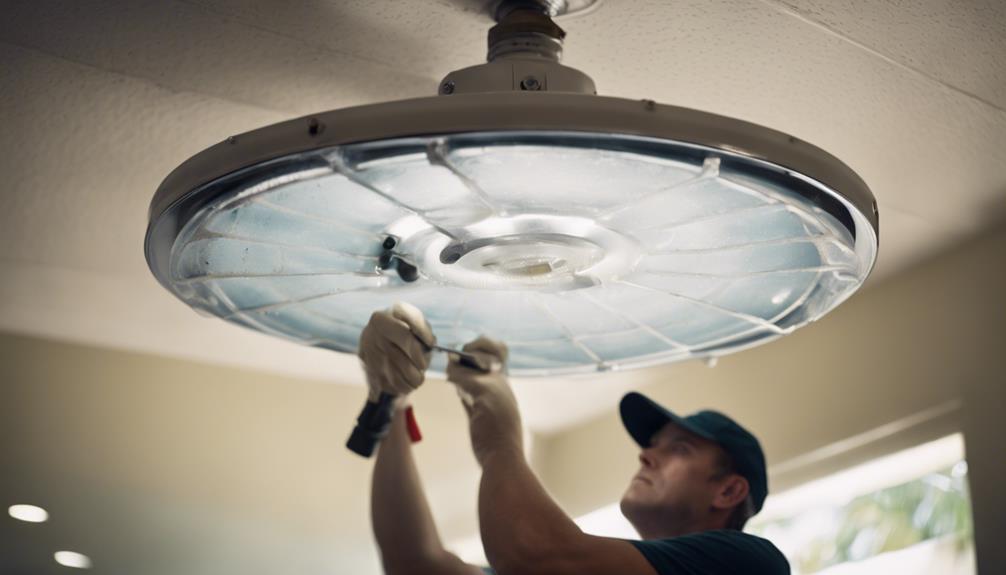
Maintaining the integrity of your pool lighting through regular inspections is essential for guaranteeing safety and functionality. Your swimming pool lights play a vital role in providing illumination and enhancing safety during night swims. By inspecting them frequently, you can spot any signs of wear or damage early on.
Make sure to check that the pool lights are securely sealed to prevent water damage and potential hazards. Annual inspections are also key to identifying any safety risks related to your pool lighting.
If you notice any worn components during your inspections, it's important to replace them promptly to reduce the risk of accidents. Properly installed and well-maintained pool lights not only contribute to the ambiance of your pool but also ensure visibility and safety for swimmers.
Enhancing Pool Safety With Lighting

Enhance pool safety during night swims by guaranteeing proper installation and maintenance of your pool lights. When it comes to lighting up your pool area, safety should be a top priority. Here are some tips to help you enhance pool safety with lighting:
- Regular Inspections:
Make sure to examine your pool lights regularly to catch any issues early on. This can help prevent accidents and ensure your lights are working properly.
- Ground-Fault Circuit Interrupters (GFCIs):
Installing GFCIs in your pool lighting system can help prevent electric shocks, making your pool a safer place for everyone to enjoy.
- Low Voltage Lights:
Opt for low voltage lights in your pool as they reduce the risk of electrocution. Safety should always come first when it comes to pool lighting.
- Professional Installation:
To guarantee the utmost safety, consider hiring a professional for the installation of your pool lights. They have the expertise to set up your lighting system correctly, keeping you and your loved ones safe while swimming at night.
Frequently Asked Questions
How Safe Are Pool Lights?
Pool lights are generally safe when properly installed and maintained. However, risks can arise from faulty wiring or damage. Regular inspections and the use of Ground Fault Circuit Interrupters (GFCIs) are key for safety.
To guarantee everything is up to code, it's wise to consult a licensed electrician for any pool light installations. Prioritizing safety measures will help you enjoy your swimming experience worry-free.
Where Is the Best Place to Put Inground Pool Lights?
So, where's the magic spot to place those inground pool lights for the ultimate vibe?
Imagine this: as you immerse yourself in the shimmering water, lights by the steps, corners, and curves guide your way like gentle fireflies in the night.
With a touch of style, lights on stairs or benches add that extra flair. Consider your pool's shape and size to create a balanced, aesthetically pleasing glow for your nighttime swims and poolside hangs.
Does Water Get Behind Pool Lights?
Water can sneak its way behind those pool lights if the seals and gaskets are worn out. That sneaky water can cause big problems like electrical hazards and damage.
To keep things safe, make sure those connections are sealed up tight. Don't forget to give your pool lights a regular check-up to catch any leaks early.
Keeping those seals snug and swapping out old gaskets will help keep the water where it belongs – in the pool!
How Deep Should Pool Lights Be Installed?
Alright, so when it comes to installing pool lights, the magic number is 18 inches. You want those lights to be at least that deep below the waterline to keep things safe and spark-free.
Going deeper than that's even better for reducing the risk of any unwanted electric surprises. Remember, different pools and brands might've their own recommendations, but sticking to that 18-inch rule is a pretty solid bet for a safer swim!
What Safety Tips Should I Follow When Installing Swimming Pool Lights?
When installing swimming pool lights, it’s crucial to take swimming pool lights safety precautions to avoid accidents. Ensure all lights are properly grounded and waterproof. Use a GFCI-protected outlet and have a professional electrician inspect the installation. Regularly check for any damaged wiring or fixtures to maintain a safe swimming environment.
Conclusion
So, next time you're thinking about adding some pizzazz to your pool with some fancy lights, remember to prioritize safety!
From choosing the right lights to proper installation techniques, there are plenty of ways to guarantee your pool is both stylish and secure.
So why not make a splash with some cool pool lights and shine bright like a diamond?
Stay safe, and happy swimming!



